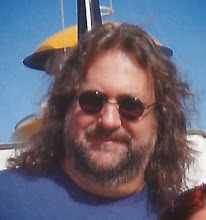We begin with "Death Watch" by Carl Wessler and George Tuska. A man tries to get a wealthy businessman with a weak heart to give up the ghost and die so that he can move in on the widow and her wealth. However, as the ailing man's spirit moves closer to the realm of the dead, it is the greedy man's thoughts that give him the resolve to fight to remain in the land of the living.
Next is "Man in the Attic" by Carl Wessler, Dick Dillin, and Frank Giacoia. A strangler is loose in the city and the residents of a boarding house are quick to believe it is somebody living there.
Our next story is "Curse of the Sea Hag" also written by Carl Wessler, and this time, drawn by Jerry Grandenetti. Jerry sneaks aboard a cursed boat.
Carroll O. Wessler, better known as Carl Wessler, was born on May 25, 1913, and began as an animator in the 1930s, working on Musical Memories and other cartoon shorts for the Fleischer Studios in New York City. The studio fired him on March 30, 1937, for labor union organizing; after a subsequent strike by studio staff, lasting from May 7 to October 13 of that year, the studio settled, and Wessler and others were rehired. Wessler followed Fleischer when it relocated to Florida the following year.
While continuing to work as an animator, Wessler began doing freelance art for comic books in 1943, through the studio Sangor-Hughes, a packager that produced outsourced comics for publishers entering the then-new medium. Wessler returned to New York when Fleischer relocated but began to move to comics full-time. Wessler's earliest confirmed credits are as a cartoonist writing and drawing such funny animal features as "Snazzy Rabbit" and "Senorita Juanita McMouse" in Laffy-Daffy Comics #1 (Feb. 1945). He also wrote and drew the humorous feature "Happy Daze" in at least two issues of Lev Gleason Publications' Daredevil in 1951.
Wessler began writing for Atlas Comics in November 1950 with "The Mad Monk" about the historical figure Grigori Rasputin, published in Amazing Detective Cases #6 (May 1951). He soon became Atlas' primary crime fiction writer, often scripting entire issues of All-True Crime, Amazing Detective Cases, Crime Can't Win, Crime Exposed, Crime Must Lose, Justice, and Kent Blake of the Secret Service. In 1952 he became a member of the Atlas bullpen, where he wrote horror/fantasy stories for such titles as Adventures into Terror, Adventures into Weird Worlds, Astonishing, Mystic, and Suspense, later adding such war comics as Battle, Battle Action, Battlefield, Combat, and Men's Adventures.
Starting in 1953, Wessler contributed a large number of stories to EC's famed horror titles Tales from the Crypt, and The Vault of Horror—writing the entirety of Tales from the Crypt #45 (Jan. 1955), for instance, with the artists including such luminaries as Graham Ingels, Jack Davis, Jack Kamen, and Bernard Krigstein. He wrote as well for EC's Aces High, Crime SuspenStories, Impact, Piracy, Shock SuspenStories, and Weird Science-Fantasy.
Following the demise of EC, Wessler returned to Atlas in late 1955 as a freelance writer. There he scripted science fiction/fantasy stories for Mystic and, prolifically, World of Fantasy. Wessler next wrote for Harvey Comics, home of Casper the Friendly Ghost and other children's characters, remaining there through the early 1970s. As well, in the 1960s, his work appears in a range of titles including Charlton Comics' Billy the Kid, DC Comics' Tomahawk, and Warren Publishing's black-and-white horror-comics magazines Creepy, Eerie, and Vampirella.
At DC Comics, Wessler wrote numerous stories for the horror anthologies Ghosts, House of Mystery, The Unexpected, and The Witching Hour from 1967 to 1985. He also contributed additional stories to Eerie and returned to his old home at the former Atlas, now Marvel Comics, with work appearing in Giant-Size Chillers vol. 2, #1 (Feb. 1975), and in the black-and-white horror-comics magazine Tales of the Zombie #7 and 10 (Sept. 1974 and March 1975). His last recorded credit is the story "Hellfire by Night" in G.I. Combat #278 (July 1985). Wessler was living in Miami, Florida, at the time of his death in 1989.
This issue ends with "Voice in the Night" by Murray Boltinoff and Rich Buckler. After a horrible car accident, a man is haunted by the voice of his wife.
Edited by Murray Boltioff.







No comments:
Post a Comment